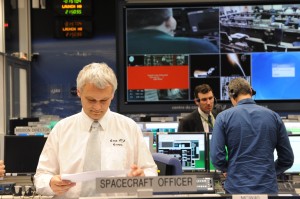We received a query yesterday from Ian Benecken who asked, “Why does it take 10 days for ATV to reach the ISS? Has that something to do with the mass of that ATV?” We sent this query to Jean-Michel Bois, Head of the ESA Operations team at ATV-CC, who provided this reply. Thanks, Ian, for your query!
The nominal duration from launch to docking is five days to ‘phase’ or synchronise the orbits of ATV and ISS. This ‘5-day’ strategy allows a standard set of manoeuvres from the orbital injection point (by Ariane at 260km altitude) and the ISS orbit, which is at between 390-410 km, independently of the launch date and of the ISS position on its orbit.
Note that the ATV launch time is set to match when the ISS vertical plane is just passing by Kourou (so phasing concerns only ATV ‘up/down’ manoeuvres, not ‘left/right’ – which are very costly in propellant).
These five days are a compromise between various constraints, mainly to minimise the propellant consumption. This duration also allows the ATV Control Centre to perform all the verifications before starting the final rendezvous phase, which is a progressive and safe approach to the Station of several hours; keep in mind also that we have no specific urgency to arrive at the Station, which is not the case for the Soyuz vehicle with crew on board.
But on top of this nominal 5-day strategy, we have two other constraints:
- At the beginning (launch) we need to free the Kourou preparation rooms and launch pad as soon as possible to allow Arianespace, which is a commercial company, to launch numerous other satellites in the year. With now three launchers (Ariane, the Soyuz launcher and Vega), the Kourou logistic situation is complex!
- At the end (docking), we need to have a free docking port on the Station and must respect several ATV/ISS constraints, e.g. minimise solar dazzling of our video sensors, or be in visibility of the Russian ground tracking stations during the critical phase of the mechanical docking and electrical ATV-ISS merging.
These two constraints (at start and end) determine the duration of the ATV in free flight phasing.
To complete the description, a too-long period could put the ATV on a ‘parking orbit’ for a while (a stable position, not too far from the ISS, roughly 1000/3000 km behind or ahead of the Station), awaiting the right time slot to start the final rendezvous and docking manoeuvres.
So, for this mission number 4, ATV and Ariane teams are conducting a preparation campaign allowing launch from 5 June. The vehicle traffic around ISS and the ATV rendezvous constraints allow a docking not before 15 June. This is the explanation of the 10 days. Note that the parking option has not been chosen for this mission, as we have preferred a slower phasing approach.


 Automated Transfer Vehicle page
Automated Transfer Vehicle page ATV blog archive
ATV blog archive
Discussion: one comment
Takže to není automat, když do letu ATV k ISS neustále z Courou zasahujete a let ATV řídíte z pozemních kontrolních stanic.
Správné jméno by mělo být jen (A) TV — a to ‘A’ vynechat. Nemyslíte?
Váš
ivo sohajek
EU (CR)
Děkuji!